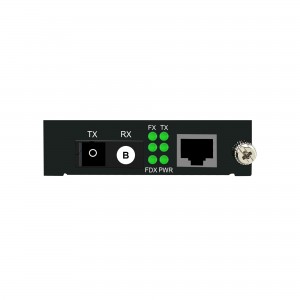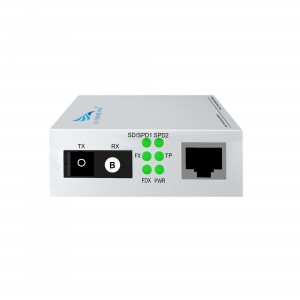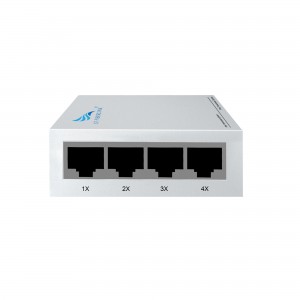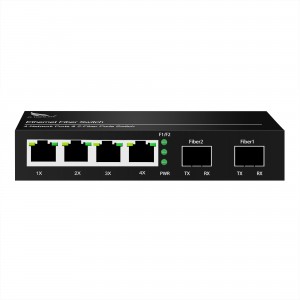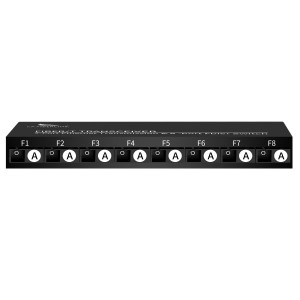2-port 10/100/1000M WDM 20km Plug-in Media Converter (single-mode single-fiber SC)B-end
2-port 10/100/1000M WDM 20km Card Media Converter (single-mode single-fiber SC)B-end
Product Features:
Introducing Revolutionary Optical Gigabit Transceivers and Optical Converters!
Welcome to Huizhou Changfei Photoelectric Technology Co., Ltd., a well-known provider of cutting-edge transmission solutions and high-quality products. With rich R&D experience and impressive optoelectronic patent portfolio, we have won the trust and appreciation of more than 360 distributors and agents in more than 100 countries around the world.
Our latest innovation combines the power of light and electricity to bring you the ultimate connectivity solution. Presenting our most advanced product range – Optical Single Mode Single Fiber Gigabit Transceivers and Optical Converters. Designed for seamless high-speed data transfer, these plug-in devices are ideal for a variety of networking applications.
Let’s take a deep dive into the features that set our product apart from the competition. First of all, the DC5-12V wide voltage power supply ensures reliable performance in various power environments. Additionally, the port is equipped with 4KV lightning protection, protecting your network from potential power surges. Wide temperature operating capability guarantees optimum function even under harsh conditions.
Our transceivers and converters are ideal for long-distance data transmission, supporting single-mode single-fiber connections over 20 km. This unrivaled range ensures uninterrupted communication over long distances, making it ideal for enterprises with vast infrastructures.
For added flexibility and adaptability to different network requirements, our devices also support 10KB jumbo frame transmission. This feature allows for larger data packets, reducing overhead and optimizing data transfer efficiency.
Installing and using couldn’t be easier! Our products are designed to be plug-and-play with a user-friendly 4-digit dial and universally compatible SC interface. Dynamic LED indicators provide real-time status updates for easy monitoring and troubleshooting.
Designed with efficiency and sustainability in mind, our products consume low power to help you reduce energy costs while minimizing your environmental impact. The card format can be easily integrated into a 16-slot rack, ensuring stable transmission without cluttering your infrastructure.
In conclusion, Huizhou Changfei Optoelectronics Technology Co., Ltd.’s optoelectronic single-mode single-fiber gigabit transceivers and optical-to-electrical converters combine cutting-edge technology, advanced features, and seamless functionality to revolutionize your network connections. With our unwavering commitment to high-quality solutions and exceptional customer service, you can trust us to meet all your networking needs.
Upgrade to the future of connectivity with our comprehensive line of products. Choose Huizhou Changfei Optoelectronics Technology Co., Ltd. for superior transmission solutions that set new standards in quality, reliability and performance. Experience the difference today!
What This Product Does
◇ CF-101GSK-20B is a gigabit media converter, providing a gigabit RJ-45 port and a gigabit SC fiber port, which can convert between electrical and optical signals.
How This Product Works
◇ CF-101GSK-20B adopts WDM (wavelength division multiplexing) technology, helping send and receive data at a distance of up to 20 km with only a single mode fiber, which saves half of the cable deployment cost for customers. CF-101GSK-20B transmits data at 1310 nm wavelength and receives data at 1550 nm wavelength on optical fiber. Therefore, the terminal device used in conjunction with the CF-101GSK-20B should send data at a wavelength of 1550 nm and receive data at a wavelength of 1310 nm. CF FIBERLINK another media converter CF-101GSK-20A is one of the products that can cooperate with CF-101GSK-20B.
Other Features
◇ Besides, this media converter can be used as a standalone device (no rack required) or used with CF FIBERLINK’s CF-2U16 rack for auto MDI/MDI-X in TX port in which duplex mode is automatically negotiated.
technical parameter:
| Model | CF-101GSK-20B | |
| Interface Characteristics | ||
| Fixed Port | 1* 10/ 100/ 1000Base-T RJ45 port
1* 1000Base-X uplink SC fiber port |
|
| Ethernet Port | 10/ 100/ 1000Base-T auto-sensing, full/half duplex MDI/MDI-X self-adaption | |
|
Twisted Pair Transmission |
10BASE-T: Cat3,4,5 UTP(≤100 meter)
100BASE-T: Cat5e or later UTP(≤100 meter) 1000BASE-T : Cat5e or later UTP(≤100 meter) |
|
| Optical Port | Default optical module is single-mode single-fiber 20km, SC port | |
| Wavelength/Distance | A-end: RX1310nm / RX1550nm 0 ~ 40KM
B-end:RX1550nm/ RX1310nm 0 ~ 40KM |
|
| A-end: RX1490nm / RX1550nm 0 ~ 120KM
B-end:RX1550nm/ RX1490nm 0 ~ 120KM |
||
| Chip Parameter | ||
| Network Protocol | IEEE802.3 10BASE-T, IEEE802.3i 10Base-T,
IEEE802.3u 100Base-TX, IEEE802.3u 100Base-FX, IEEE802.3x IEEE802.3ab 1000Base-T;IEEE802.3z 1000Base-X; |
|
| Forwarding Mode | Store and Forward(Full Wire Speed) | |
| Switching Capacity | 4Gbps | |
| Buffer Memory | 3Mpps | |
| MAC | 2K | |
|
LED Indicator |
Fiber | FX(green) |
| Data | TP (green) | |
| Single / duplex | FDX (green) | |
| Power | PWR (green) | |
| Power | ||
| Working Voltage | AC:100-240V | |
| Power Consumption | Standby<1W, Full load<5W | |
| Power Supply | DC:5V/2A industrial power supply | |
| Lightning protection &Certification | ||
| Lightning protection | Lightning protection: 4KV 8/20us, Protection level: IP30 | |
| Certification | CCC;CE mark, commercial; CE/LVD EN60950;FCC Part 15 Class B; RoHS | |
| Physical Parameter | ||
| Operation TEMP | -20~+55°C;5%~90% RH Non condensing | |
| Storage TEMP | -40~+85°C;5%~95% RH Non condensing | |
| Dimension (L*W*H) | 98mm*75mm*2mm | |
| Installation | Desktop, CF-2U16 slot rack | |
Product Size:
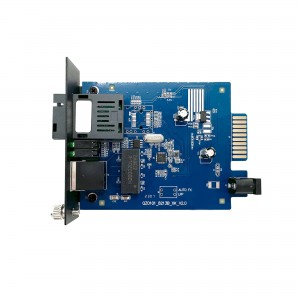
Product application diagra:

How to choose a fiber optic transceiver?
Optical fiber transceivers break the 100-meter limitation of Ethernet cables in data transmission. Relying on high-performance switching chips and large-capacity caches, while truly achieving non-blocking transmission and switching performance, they also provide balanced traffic, isolation and conflict. Error detection and other functions ensure high security and stability during data transmission. Therefore, fiber optic transceiver products will still be an indispensable part of actual network construction for a long time. So, how should we choose fiber optic transceivers?
1. Port function test
Mainly test whether each port can work normally in the duplex state of 10Mbps, 100Mbps and half-duplex state. At the same time, it should be tested whether each port can automatically select the highest transmission speed and automatically match the transmission rate of other devices. This test can be included in other tests.
2. Compatibility test
It mainly tests the connection ability between the optical fiber transceiver and other devices compatible with Ethernet and Fast Ethernet (including network card, HUB, Switch, optical network card, and optical switch). The requirement must be able to support the connection of compatible products.
3. Cable connection characteristics
Test the fiber optic transceiver’s ability to support network cables. First, test the connection ability of Category 5 network cables with lengths of 100m and 10m, and test the connection ability of long Category 5 network cables (120m) of different brands. During the test, the optical port of the transceiver is required to have a connection capability of 10Mbps and a rate of 100Mbps, and the highest must be able to connect to a full-duplex 100Mbps without transmission errors. Category 3 twisted pair cables may not be tested. Subtests can be included in other tests.
4. Transmission characteristics (transmission loss rate of data packets of different lengths, transmission speed)
It mainly tests the packet loss rate when the optical fiber transceiver optical port transmits different data packets, and the connection speed under different connection rates. For the packet loss rate, you can use the test software provided by the network card to test the packet loss rate when the packet size is 64, 512, 1518, 128 (optional) and 1000 (optional) bytes under different connection rates. , the number of packet errors, the number of packets sent and received must be more than 2,000,000. Test transmission speed can use perform3, ping and other software.
5. The compatibility of the whole machine to the transmission network protocol
It mainly tests the compatibility of fiber optic transceivers to network protocols, which can be tested in Novell, Windows and other environments. The following low-level network protocols such as TCP/IP, IPX, NETBIOS, DHCP, etc. must be tested, and the protocols that need to be broadcast must be tested. Optical transceivers are required to support these protocols (VLAN, QOS, COS, etc.).
6. Indicator status test
Test whether the status of the indicator light is consistent with the description of the panel and the user manual, and whether it is consistent with the current status of the fiber optic transceiver.








